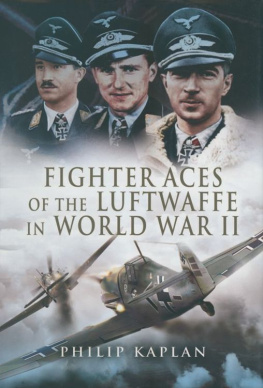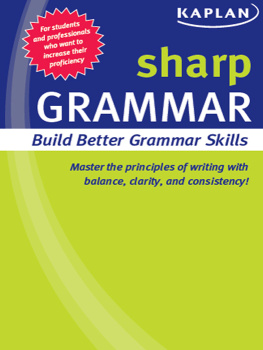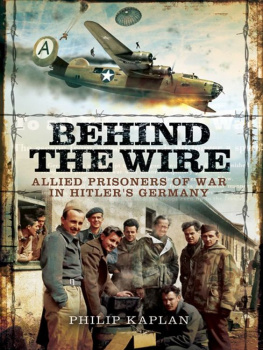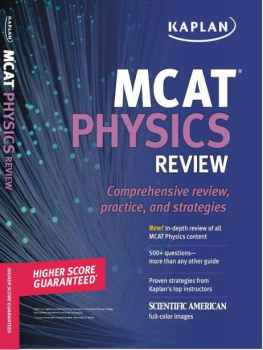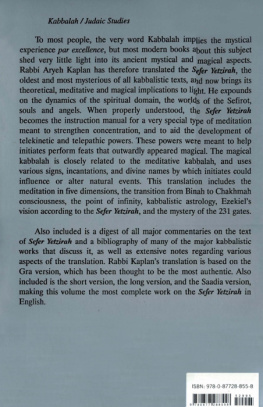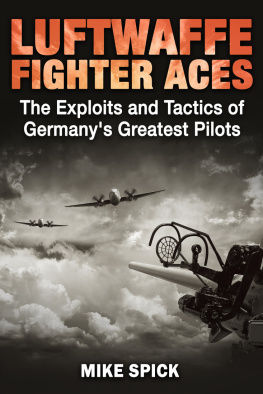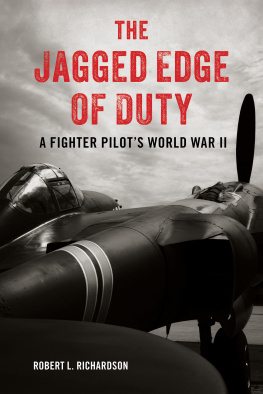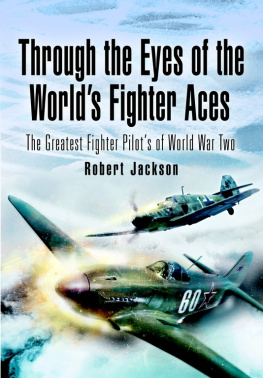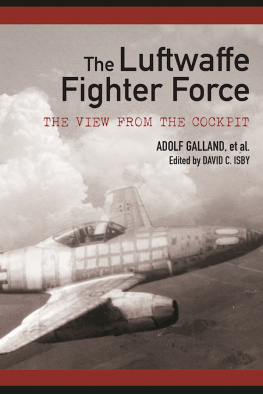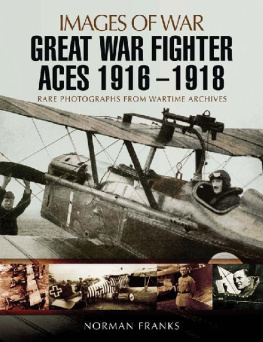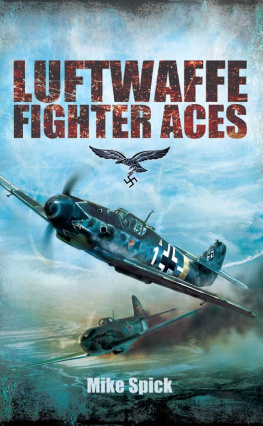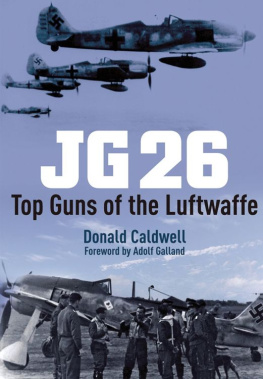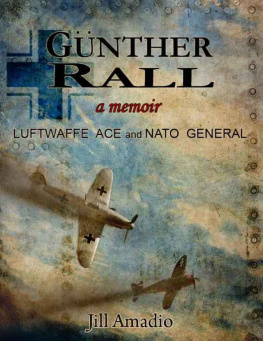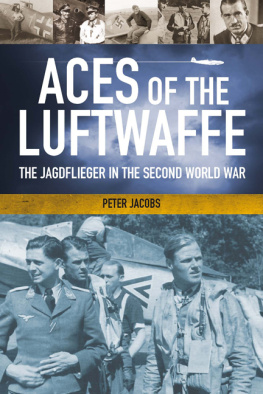FIGHTER ACES
OF THE
LUFTWAFFE
IN WORLD WAR II
FIGHTER ACES
OF THE
LUFTWAFFE
IN WORLD WAR II
PHILIP KAPLAN
First published in Great Britain in 2007 by
Pen & Sword Aviation
an imprint of
Pen & Sword Books Ltd
Copyright Philip Kaplan, 2007
ISBN 978-1-84415-460-9
The right of Philip Kaplan to be identified as Author of this Work has been
asserted by him in accordance with the Copyright,
Designs and Patents Act 1988.
A CIP catalogue record for this book is
available from the British Library
All rights reserved. No part of this book may be reproduced or transmitted in
any form or by any means, electronic or mechanical including photocopying,
recording or by any information storage and retrieval system, without
permission from the Publisher in writing.
Typeset in Times New Roman by
Phoenix Typesetting, Auldgirth, Dumfriesshire
Printed and bound in England by
Biddles Ltd, Kings Lynn
Pen & Sword Books Ltd incorporates the Imprints of Pen & Sword Aviation, Pen
& Sword Maritime, Pen & Sword Military, Wharncliffe Local History,
Pen & Sword Select, Pen & Sword Military Classics and Leo Cooper.
For a complete list of Pen & Sword titles please contact
PEN & SWORD BOOKS LIMITED
47 Church Street, Barnsley, South Yorkshire, S70 2AS, England
E-mail: enquiries@pen-and-sword.co.uk
Website: www.pen-and-sword.co.uk
Contents
Acknowledgements
T he author is grateful to the following people for their generous assistance and contributions made in the development of this book: Malcolm Bates, Tony Bianchi, Peter Coles, James H. Doolittle, Adolf Galland, Gerd Gloystein, Stephen Grey, Mark Hanna, Ray Hanna, Margaret Kaplan, Neal Kaplan, Wade Meyers, Michael OLeary, Geoffrey Page, Horst Petzschler, Gunther Rall, Christine Seidel, Klaus Seidel, Peter Vogler, Duke Warren.
F ollowing Germanys defeat in World War One, the victorious Allies convened at Versailles to debate the future of the German nation and to hammer out what many have since recognized as a vindictive peace treaty. Four years spent in a losing cause had taken Germany to the brink of bankruptcy, forcing her to sue for peace and accept any terms offered. The Allies gathered in the French palace with the mutual goal of eliminating the military and economic strength of Germany through the Treaty of Versailles, which was signed in June 1919.
The German people were impoverished and gravely short of food and all other necessities of life. Their nations few remaining military assets included a still-sizeable Naval force, the Army and the Flying Corps. One aim of the representatives at Versailles was to end Germanys military aviation capability. Resurrection of the German Flying Corps would be prohibited. Under the monitoring of the Allied Control Commission, the Germans were compelled to turn over all of their aircraft and aeronautical material to the governments of the Allied powers during 1920. This amounted to the surrender of more than 15,000 aircraft and 27,000 aero engines. The framers of the treaty, however, did not include a long-term provision to prevent the manufacture and mass production of civilian aircraft. This oversight resulted from the Allies failure to recognize the potential of civil aviation in the years to come.
In spite of all the restrictions, limitations and prohibitions of the treaty, the Germans capitalized on the civil aviation loophole and plunged headlong into the development of commercial airlines, flying and gliding clubs and aviation training schools. They trained pilots and pursued the design, engineering and construction of many new and conceptually advanced aircraft. Their efforts formed the nucleus of the clandestine German Air Force.
Adolf Hitler and Hermann Goering did not found the German Air Force. It was General Hans von Seeckt who began to plan for the new Luftwaffe in 1920, even while the German Flying Corps was being eliminated. Von Seeckt was Chief of the Army Command at the German Defence Ministry and was able to create and staff a small sub rosa group of regular officers within his department to deal exclusively with special aviation matters. The Allies would come to regret their negligence in not breaking up the surviving and highly effective core of the German Army Staff, for from it came the members of von Seeckts special aviation department, including Hugo Sperrle, Walther Wever and Albert Kesselring, who would rise to principal commands in the Luftwaffe during World War Two.
In the 1920s, the German aircraft makers Heinkel, Junkers, Dornier, and Focke-Wulf were formed, followed by Messerschmitt. Their development of new and varied aircraft (ostensibly for civil use), laid the groundwork for equipping a new German Air Force and, in 1924, von Seeckt arranged future cooperation between the Civil Aviation Department of the Ministry of Transport and his Defence Ministry by securing the appointment of a colleague to head the CAD. Thereafter, German civil aviation would develop under clandestine military control.
The year 1926 saw the establishment of Deutsche Lufthansa, the German State airline and, with it, the development and construction of many large airfields. The chairman of Lufthansa was Erhard Milch, who would become the production chief for Hermann Goerings Luftwaffe in the next world war. Milch oversaw the pioneering developmental work in flying instrumentation and radio navigation and his airline rapidly became the best in Europe. Its pilots and navigators would form the basic training organization of the new Luftwaffe.
While Lufthansa was growing, so, too, was the Deutscher Luftsportverband, an organization of more than 50,000 members whose involvement in sport flying and gliding had been encouraged by von Seeckts Defence Ministry as another way around the restrictive clauses of the Versailles Treaty. Von Seeckt had determined to make Germany air-minded and in another clandestine move, an agreement with the Soviet Union was entered into, giving service personnel military flying instruction at the Lipetsk training centre. Thus, by the 1933 accession of Adolf Hitler and the Nazi Party to power in Germany, the foundation of the new Luftwaffe was firmly in place.
Barely two years after Hitler took power, he openly flaunted the Treaty of Versailles, announcing a major rearmament programme. In it he called for development of a Reichsluftwaffe which would put a steel roof over Germany. By 1935, Germany had a frontline air strength of eight squadrons three of fighters and five of bombers. They were, of course, illegal under the terms of Versailles. Hitler even embellished his annual mass rallies at Nuremberg with low-level flypasts by these aircraft which now wore the black cross insignia of the Luftwaffe. The propaganda message for the rest of the world was clear and intentional. Goerings man, Erhard Milch, was quietly generating production miracles, raising the annual manufacturing output of the German aircraft industry from a few hundred to thousands of planes. Gone from the inventory of the young Luftwaffe were the old, obsolete machines that had been purchased for training. They had been replaced by a range of powerful, all-metal monoplane types of superb and advanced design and capability.
During the Spanish Civil War in the mid-thirties, when Hitler offered Germanys assistance to the Franco government of Spain, the new Luftwaffe was given an ideal opportunity to try out its latest weaponry in combat conditions. Many of the future aces and leaders of the World War Two
Next page
